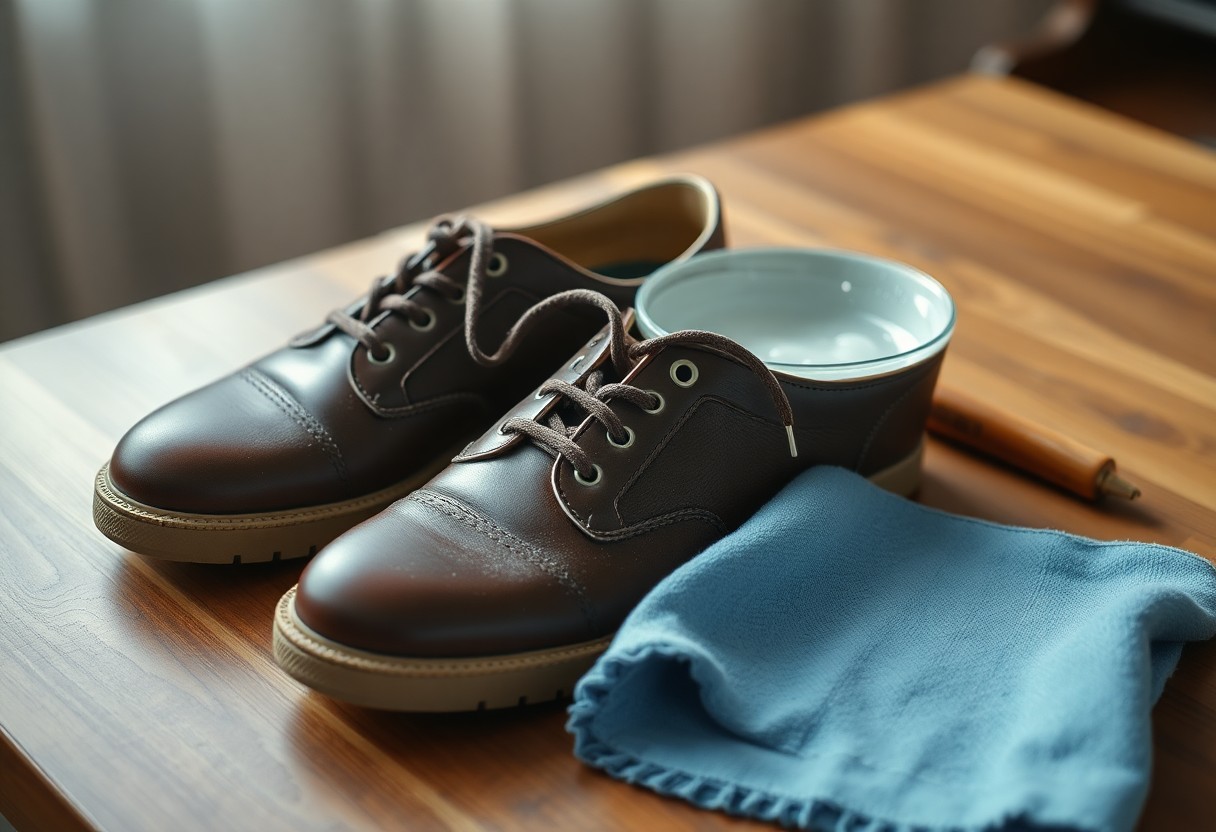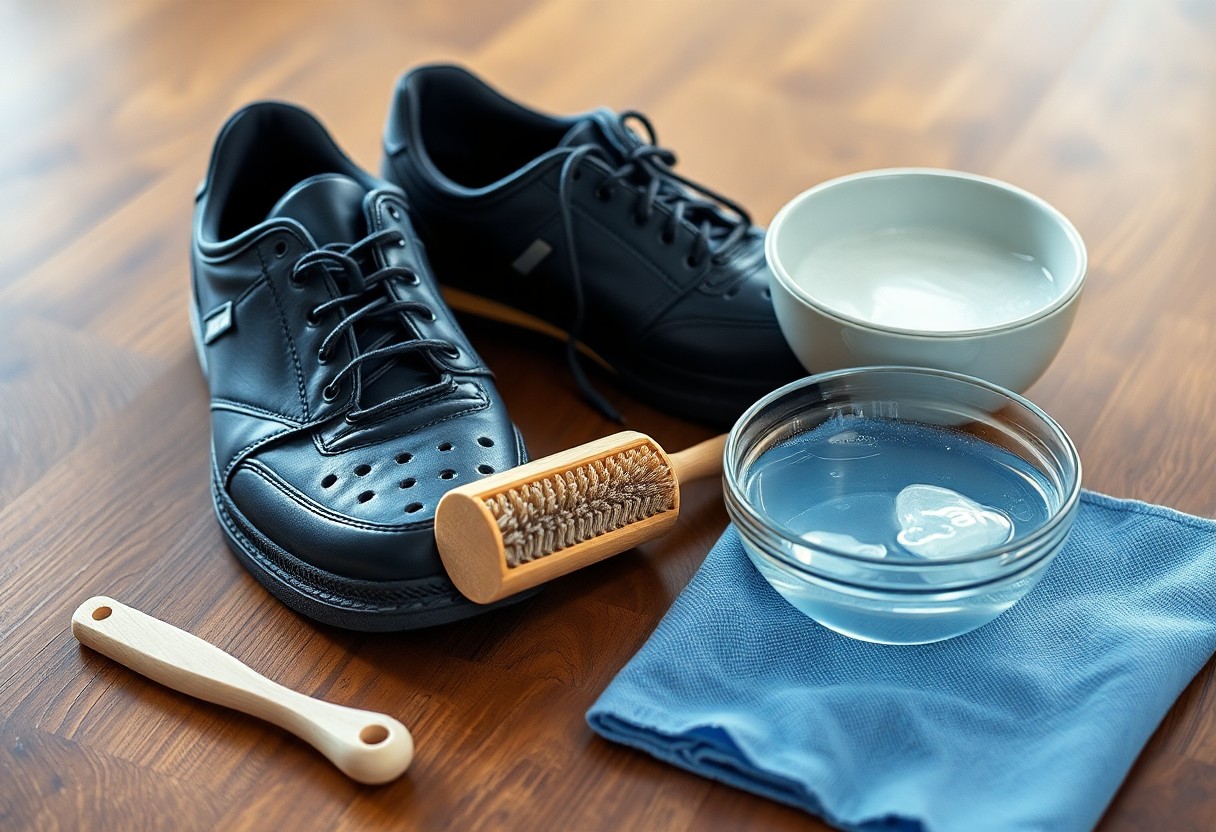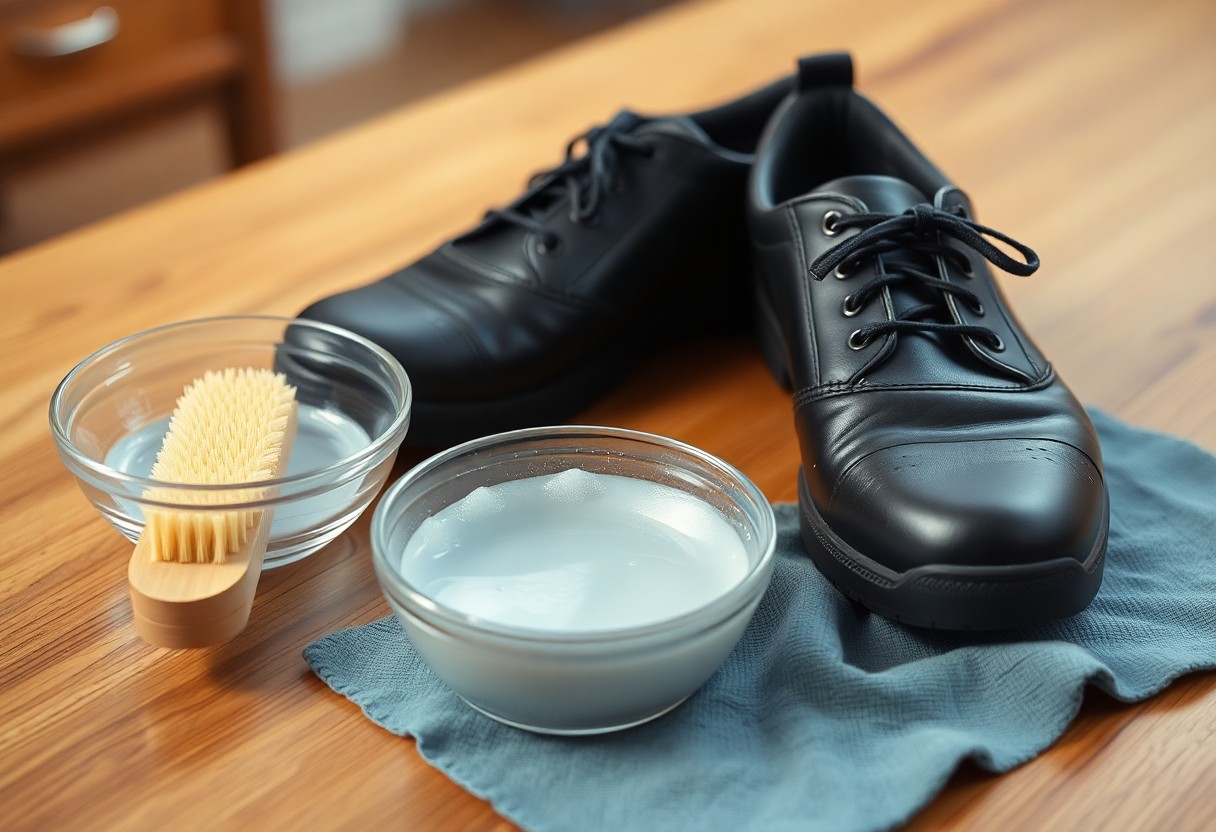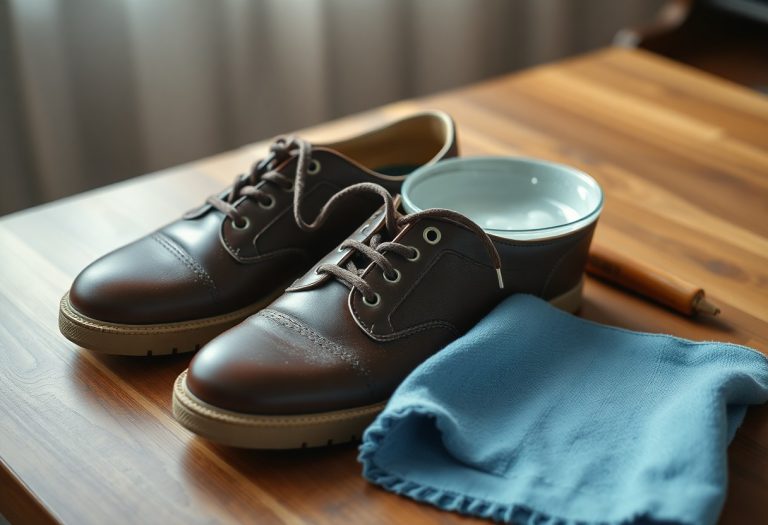It’s common to discover unexpected plastic residues on your shoes, particularly in welted footwear. During the manufacturing process, manufacturers employ plastic covers to protect the leather uppers from damage. While these remnants may appear concerning, rest assured they do not compromise your shoes’ quality or durability. You can easily manage this issue at home by utilizing simple tools. Using tweezers, carefully pull out any visible plastic strips that may emerge between the sole and upper. After removal, apply shoe cream to protect the newly exposed leather areas. This straightforward maintenance task not only helps keep your shoes looking clean and well-maintained but also ensures their longevity and overall appearance.

How to Identify and Effectively Manage Plastic Residues in Your Footwear
The presence of plastic residues on your shoes is a typical outcome of the manufacturing process, where protective coverings are utilized to shield the leather during production. These residues generally manifest between the sole and upper leather, resulting in visible strips that may gradually emerge over time. By understanding these remnants, you can effectively manage and address them, ensuring your shoes remain in optimal condition and maintain their aesthetic appeal. Recognizing these residues early allows for timely intervention, which is crucial in preserving the integrity and beauty of your footwear.
Understanding the Manufacturing Process That Results in Plastic Residues
In contemporary shoe production, protective plastic covers are strategically applied to prevent any damage during assembly. Throughout various stages of manufacturing, these covers serve to shield the leather from potential stains, scratches, and chemical exposure, ultimately preserving the quality of your footwear. Understanding this process can give you greater insight into why these residues appear and how to address them. Awareness of the manufacturing techniques can empower you as a consumer to make informed choices about shoe maintenance and care, ensuring your footwear remains as pristine as possible.
Exploring Different Types of Protective Coverings Used in Shoe Manufacturing
When examining common protective materials, two primary categories emerge: heat-shrink wraps and adhesive tapes. These protective elements fulfill specific roles during production:
- Heat-shrink plastic – Provides full upper coverage
- Adhesive tape – Delivers targeted protection
- Combination wraps – Offers enhanced security
| Coverage Type | Protection Level |
|---|---|
| Full Wrap | High |
| Partial Tape | Medium |
| Heat-shrink | Maximum |
| Reinforced | Very High |
| Basic Cover | Standard |
Understanding the characteristics of these protective coverings is essential for identifying and addressing residue issues effectively. It is common for your shoes to show signs of plastic emergence near the welt or sole edges, which is a normal occurrence. By employing proper removal techniques, you can maintain your footwear’s appearance and ensure their longevity, thereby enhancing your overall shoe experience. Proactive care and knowledge about the materials used in your shoes can significantly improve their lifespan.
| Residue Location | Removal Method |
|---|---|
| Welt Area | Tweezers |
| Sole Edge | Gentle Pulling |
| Storm Welt | Careful Extraction |
| Heel Edge | Professional Tools |
| Upper Join | Precise Removal |
How to Spot Plastic Residues: A Comprehensive Guide for Shoe Owners
While inspecting your shoes, you might come across thin, transparent strips poking out between the upper and sole. These residues result from the protective covers employed during manufacturing, with approximately 85% of welted shoes containing some form of plastic remnants. Learning to spot these residues will enable you to maintain your shoes effectively, keeping them in pristine condition and enhancing their overall aesthetic. Regular inspections can help you catch emerging issues before they develop into more significant problems, ensuring your footwear looks its best.
Identifying Typical Areas for Plastic Residue Accumulation in Shoes
Upon examining your shoes, you will usually find plastic residues in specific locations. The most frequent spots for these remnants include the welt joint, storm welt areas, and the inside arch of the shoe. These areas are where the protective covering was cut during manufacturing, leaving behind small pieces trapped between the leather and sole. Recognizing these typical locations can help you quickly address any emerging residue issues, allowing for a proactive approach to shoe maintenance that enhances their durability.
Visual Characteristics: How to Identify Plastic Residues in Your Footwear
By inspecting your shoes closely, you can identify plastic residues through their distinctive features. They often appear as shiny, thin strips or fragments that protrude from the construction joints of the shoe. The material typically has a clear or slightly yellowish tint, making it easily distinguishable from the leather and sole materials. A thorough inspection in well-lit conditions will enhance your ability to spot these residues. The plastic pieces may range from barely visible strips to larger sections that are clearly noticeable against the shoe’s surface. These residues do not harm your shoes, but their presence can detract from the overall aesthetics of your footwear, making timely removal essential for maintaining a polished look.

Proven Techniques for Effectively Removing Plastic Residues from Shoes
Even the most well-crafted shoes can exhibit plastic residues stemming from the manufacturing process. It is crucial to provide your shoes with proper care and attention to safely remove these remnants without inflicting damage on the leather or sole construction. By taking the right steps, you can ensure your footwear looks its best and continues to serve you well over time. Regular maintenance and timely interventions are key to preserving the quality of your shoes.
Essential Tools for Successfully Removing Plastic Residues from Footwear
To efficiently eliminate plastic residues, you will need a specific set of tools. Your basic toolkit should include fine-tipped tweezers, a small brush, shoe cream, and optionally, a heated knife for particularly stubborn residues. Having the right tools at hand will make the removal process smoother and more effective. Equipping yourself with these tools not only simplifies the task but also minimizes the risk of damaging your shoes during the cleaning process.
Step-by-Step Guide for Safely Removing Plastic Residues from Shoes
| 1. Inspect the shoes | Check welt areas and sole edges for visible plastic |
| 2. Use tweezers | Grip plastic firmly but avoid scratching leather |
| 3. Pull gently | Remove plastic in one steady motion |
| 1. Clean exposed areas | Use brush to remove loose particles |
| 2. Apply shoe cream | Protect newly exposed leather |
| 3. Final inspection | Check for any remaining residues |
Alongside the basic steps, it’s important to pay special attention to the welt area, as this is where plastic residues commonly accumulate. Never use sharp metal tools that could cause damage to your shoes. After the removal process, condition the exposed areas to maintain the quality of the leather, ensuring your shoes remain in excellent condition for years to come. Regular upkeep and careful handling will ensure that your shoes continue to provide comfort and style.
Post-Removal Care: Ensuring Your Shoes Remain in Optimal Condition
Post-removal shoe care is crucial for maintaining your footwear’s overall condition. After removing plastic residues, you should clean the affected areas using a soft brush to eliminate any loose particles. Following this, inspect the edges meticulously for any lingering plastic pieces that could potentially damage the leather or stitching, ensuring every detail is attended to. This thorough approach to post-removal care will significantly enhance the longevity and appearance of your shoes.
Applying Leather Treatment for Optimal Care After Residue Removal
Immediately applying a high-quality leather conditioner will aid in restoring moisture to areas previously covered by plastic. Utilize a small applicator brush to work the conditioner into the newly exposed leather, paying particular attention to the welt area where the plastic was removed. This treatment will prevent the leather from drying out, ensuring your shoes maintain their luxurious feel and appearance over time. Regular conditioning sessions will keep the leather supple and prevent cracking, thereby maintaining the overall quality of your footwear.
Final Touches for Edge Maintenance After Cleaning
The finishing touches involve meticulous attention to the edges from which the plastic was removed. You should apply edge dressing to restore the color uniformity of the sole edges. This step is essential for blending any visible marks left from the plastic removal process, while also protecting the exposed areas from moisture and other environmental factors. Regular edge maintenance is advised every 3-4 months to keep your shoes looking their best. By consistently caring for the edges, you can prevent premature wear and enhance the overall durability of your footwear.
Be vigilant for any new plastic pieces that may emerge, as this occurrence is common in factory-made welted shoes. Utilize tweezers to remove any visible plastic, followed by reapplying edge dressing to uphold a clean, polished appearance. Staying proactive in your shoe care routine can make a significant difference in the longevity and aesthetics of your footwear.
Preventive Strategies to Avoid Plastic Residue Problems in Footwear
To keep your shoes safe from plastic residue issues, it is important to utilize proper storage techniques and to avoid exposure to high temperatures, which can lead to hidden plastic remnants surfacing. Store your shoes in a cool, dry place with temperatures maintained between 60-70°F (15-21°C) to prevent any potential plastic migration. Proper storage can significantly prolong the life of your footwear. By creating a suitable environment for your shoes, you can minimize the risk of future residue problems.
Establishing a Regular Inspection Routine for Your Shoes
For optimal shoe maintenance, it is recommended that you check your footwear every 2-3 weeks for signs of emerging plastic residue. Focus on the crucial regions where the upper meets the sole, particularly around the welt area, where plastic remnants frequently appear. Early detection can help prevent more significant issues from developing, ensuring your shoes remain in great shape and retain their appeal. Consistent inspections are a preventive measure that can save you time and effort in the long run.
Implementing Effective Maintenance Guidelines for Long-lasting Shoes
Before wearing a new pair of shoes, it is essential to thoroughly examine the welt area for any visible plastic remains. By promptly removing any detected residue using clean tweezers, you can prevent future complications while maintaining the shoe’s overall appearance. Regular shoe inspections should be integrated into your care routine. Employ a small brush to gently clean the welt area, followed by the application of shoe cream to protect exposed leather after any plastic removal. Consistent care will extend your shoes’ lifespan and uphold their professional appearance, making them a worthwhile investment.

Exploring Professional Solutions for Stubborn Plastic Residues
Not all plastic residue challenges can be resolved at home. Professional shoe repair services provide specialized tools and expertise to remove persistent plastic residues without causing damage to your footwear. These experts utilize heat-controlled equipment and professional-grade solvents that are safer and more effective than DIY methods, ensuring your shoes are treated with the utmost care. Engaging professional services can alleviate stress and guarantee that your footwear receives the best possible treatment.
Recognizing When to Seek Expert Assistance for Residue Removal
Seeking professional help becomes imperative when you encounter extensive plastic residue or if your attempts to remove it have proven unsuccessful. It is advisable to consult professionals if your shoes are made from delicate materials or if the plastic has become deeply embedded between the sole and upper leather, as they can provide the necessary care without risking damage to your beloved footwear. Understanding when to consult a professional is crucial for maintaining the integrity of your shoes.
Recommended Professional Services for Optimal Results in Shoe Care
Recommended professional services include specialized plastic removal treatments, leather reconditioning, and protective coating applications. The costs for these services typically range between $30-$75, depending on the extent of plastic residue and the overall condition of your shoes. Investing in professional care can be beneficial for maintaining the integrity and appearance of high-quality footwear. Professional treatment can enhance your shoes’ performance and aesthetics, ensuring they continue to meet your standards.
Given the value and material of your shoes, professional shoe care specialists can offer additional treatments such as leather conditioning and edge dressing following plastic removal. They employ specialized heat treatment methods, similar to those used in shoe factories, ensuring safe and complete removal of plastic residues while preserving your footwear’s integrity and style. Leveraging expert services can extend the life and beauty of your shoes significantly.
Key Takeaways for Maintaining Your Footwear and Effectively Managing Residues
In summary, your strategy for managing plastic residues on shoes necessitates meticulous attention to detail and the right tools. By utilizing tweezers to carefully extract visible plastic strips and following up with proper leather care, you can effectively handle this common manufacturing byproduct. Your shoes will maintain their pristine appearance when you promptly address these residues and apply shoe cream to newly exposed areas. By adhering to these straightforward steps and employing the appropriate techniques, you can ensure your footwear remains clean and well-maintained, maximizing your investment in quality shoes through extended wear and enhanced aesthetics.
Frequently Asked Questions About Managing Plastic Residues in Shoes
Q: How do I safely remove visible plastic residues from my shoes?
A: To safely remove visible plastic residues, use tweezers to grip the plastic strip firmly and pull gently. Once you have a good grip, switch to using your fingers and slowly pull to remove as much plastic as possible in one piece. Avoid pulling too hard, as this may cause the plastic to break, complicating the removal process. After removal, apply shoe cream between the upper and sole edge to protect the newly exposed leather and maintain its quality.
Q: Will removing plastic residues damage my shoes?
A: No, the process of removing visible plastic residues will not damage your shoes. The plastic is merely a leftover from the manufacturing process and serves no structural purpose. The removal process is safe when executed carefully with tweezers. Any plastic inside the shoe that isn’t visible can remain in place, as it poses no harm to the shoe’s structure or comfort, allowing you to enjoy your footwear without concern.
Q: How can I prevent plastic residues from appearing on my shoes?
A: Preventing plastic residues from appearing is not entirely possible, as they are a normal aspect of shoe manufacturing that protects the leather during production. The plastic may work its way out over time due to wear and movement. However, regular shoe maintenance and cleaning will help you detect any emerging plastic pieces early, facilitating easier removal before they become more noticeable and impacting the look of your shoes. Being proactive in your shoe care routine is essential for maintaining their quality.
The Article How to handle plastic residues on shoes tips for effective cleaning and care appeared first on My Shoes Finder
The Article Plastic Residues on Shoes: Effective Cleaning Tips and Care Was Found On https://limitsofstrategy.com
References:
Plastic Residues on Shoes: Effective Cleaning Tips and Care




